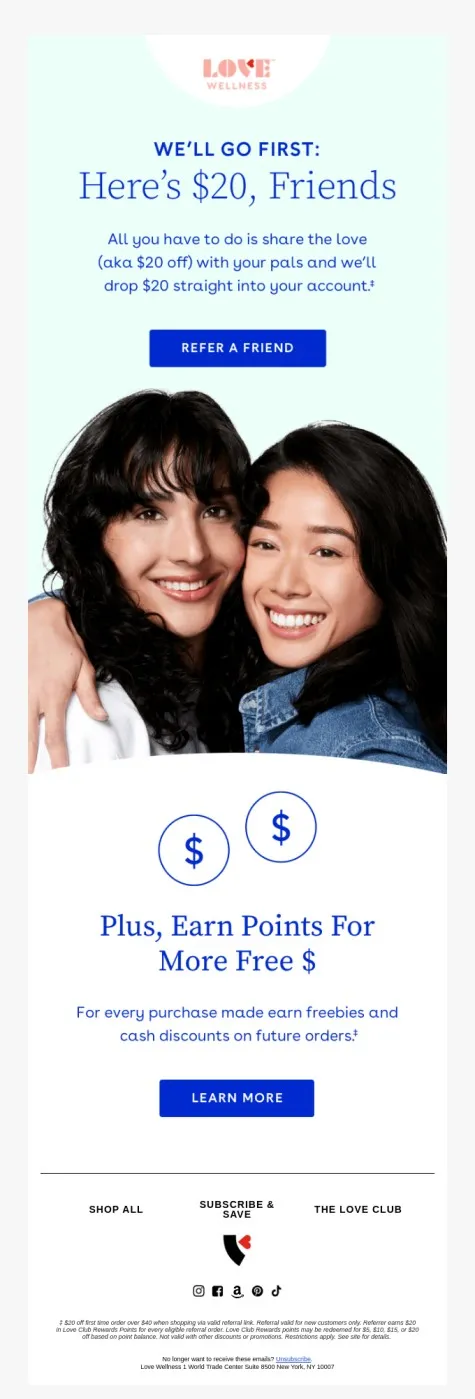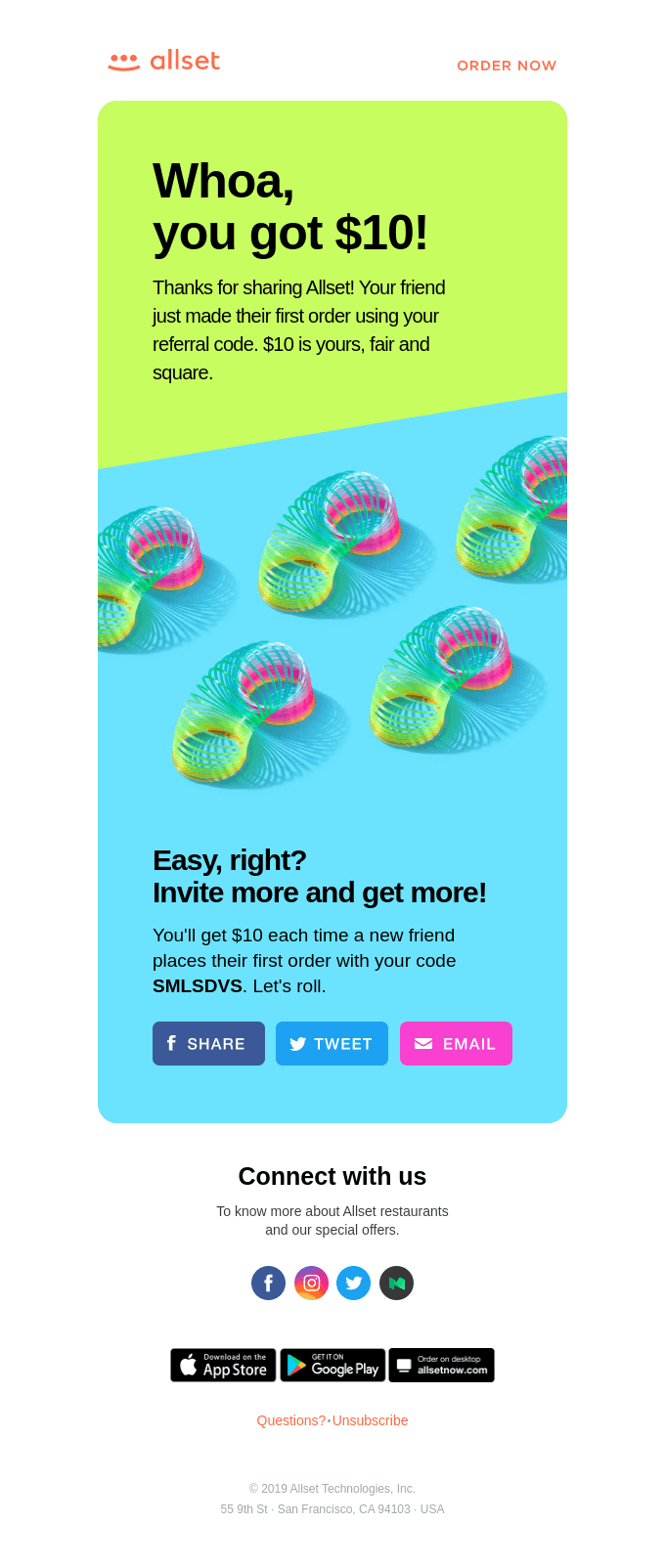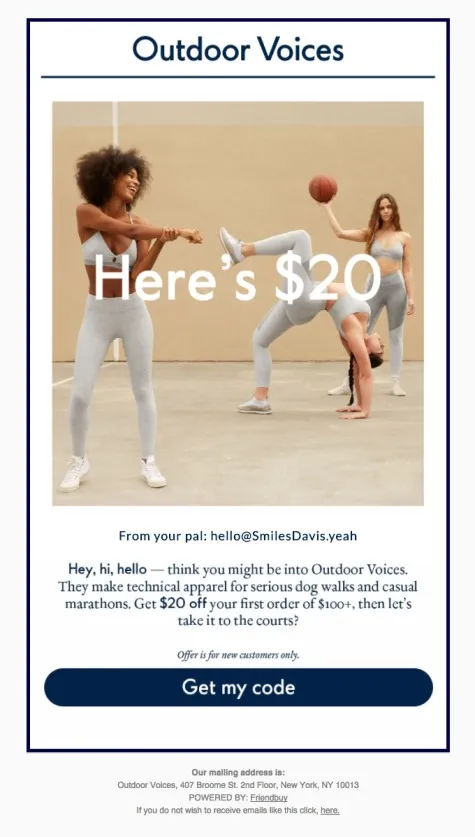
“We’re going to give you 20% off your next purchase, but we’re not going to tell you how to get the discount!”
If you received an email like this from a brand you recently purchased from, you’d probably close it or unsubscribe… Very quickly.
This is what it feels like to get a referral email campaign that doesn’t explain how the referral process works—or doesn’t make it easy to actually make a referral.
It’s great that brands are promoting their program via email. But there’s more to it than just announcing the fact that you have a referral program whenever you get the chance. Every good referral email campaign calls for five key ingredients to complete the recipe:
And yes, email is still one of the best channels for sharing your referral program. Why? According to Lisa Oberst, Director of Email Marketing at Fuel Made, “Email is great to promote your referral program because you can share details with customers right after they have tried their product. You can also easily explain how it works and the benefits. Then you can send timely updates on referral activities.”
Not to mention it has the highest ROI of any marketing channel. In fact, email campaigns have 50–100 times the click-through rate of Facebook and Twitter.
I spoke to Lisa Oberst to learn more about what makes a great referral email campaign. Let’s dive into her tips!
You may be sending customers a dedicated referral email already, but I’ll let you in on a secret: you can and should promote your referral program in a variety of email campaigns and flows.
That is because your customers might not be aware of the benefits of your referral program. Communicating the perks repeatedly in different ways educates and reminds them to refer their friends.
As for how often you should send referral emails, there’s no correct number. Most marketers would say, the answer is, “it depends.” You have to look at the type of flows you have set up and where an email like this naturally fits.
A few options are:
Your referral program won’t be the main highlight of these emails, but you can subtly promote it in the footer or in a section below the main fold. For example, see how Equal Parts weaves its referral program into its post-purchase thank you email:

That being said, you might not want to promote your referral program in your welcome flow. Lisa explains why: “I'd focus on the post-purchase flow and not mention the program in the welcome flow. It doesn't make sense to ask someone who hasn't bought from you yet to become an advocate, even if they'd get a discount this way. But then again, that could be something to test!”
Now that you know when to send these campaigns, let's explore how you can make them impactful.
According to Lisa, the most important part of a referral email campaign is to make sure it’s easy to actually refer a friend.
Sounds simple enough, right?
Unfortunately, this isn’t always the case, and customers are left spending unnecessary time logging into their account, searching for their special code, and manually emailing it to a friend.
In addition to making the process easy, Lisa shared more key advice on what a good referral email campaign should have, including:
With that in mind, let's look at the referral emails of five brands.
Sometimes the best way to learn is to reflect on what other people have done. I asked Lisa to look at five referral emails and break down what’s working and where she thinks they can improve.
Let’s put all of your newly discovered advice on referral emails into practice, starting with Braxley Bands (a brand that Lisa and her team actually work with)!
The founder of Braxley Bands works with Lisa to optimize his email marketing. So after Braxley launched its referral program, Lisa’s team sent an email campaign announcing it. On the day the email campaign went out, Braxley Bands saw its highest referral revenue ever.

Lisa shared five reasons why it works well:
This email is also used in Braxley’s post-purchase flow, specifically hitting customers’ inboxes on day 27 after their purchase. Why day 27? Waiting this long is a good time because the customer has had the product in their hands for a little while and can advocate for it honestly.
Beyond the email content, the email also directs customers to a dedicated landing page, which clearly communicates what the customer is supposed to do to make their referral. In three clear steps, the “How it works” section on the page explains how to make the referral and the benefit of doing it.
.webp)

After peaking at Peloton’s referral email, Lisa saw the value immediately at the top—in the hero image, to be exact. Customers see the “Give $100 get $100,” which feels like a much more enticing offer than the standard “10%.”
Another benefit to this email is that it clearly explains the process of making the referral. The paragraph below the hero image tells customers how to share their code and what they can expect once someone uses it.
As for where this email can improve, Lisa suggests explaining additional reasons why customers should invite friends to purchase from Peloton. For example, they can highlight the idea of joining the same classes together to support each other’s fitness goals.
Finally, the section promoting women’s and men’s clothing should be removed. It’s a distraction from the action the reader should take: to make the referral. Instead, this space could be used to talk about the additional benefits that Lisa shared.

In this referral email by Love Wellness, the text is a bit misleading. The way it’s currently written, it comes off as if the customer automatically gets $20 just by sharing—not when a friend actually makes a purchase.
It’s important to make this message clearer, especially to avoid disappointing any customers.
While the email is simple enough to get the point across, it’s missing some key information. In fact, a lot of the copy that’s placed in the footer should be used in the body of the email. Where it sits currently, people likely won’t read it.
Transparency is important to customers, so Love Wellness will do a better job in building trust if they include these terms in the email body instead.

If you’re looking for inspiration for a more simple—yet eyecatching—referral email, Allset is a great example. The email design is beautiful and the copy is engaging.
It’s smart for Allset to include the social sharing links, making it easy for shoppers to share their love for Allset with all of their friends and family on the channel they prefer.
One question Lisa had when reviewing this email was how were customers supposed to claim their $10 after making a referral. If Allset explains how users can do that, they’d have an A+ referral email in their hands.

We’ve gone through several email campaigns promoting referral programs, but what about the emails that customers receive? Let’s look at what people receive from friends who refer them to Outdoor Voices.
Lisa noted the short description of what Outdoor Voices is. Including this is helpful to the person receiving the email because they may not be familiar with the brand yet. Essentially, sharing your mission, values, or story can help those being referred get on board with supporting your business.
One area this email can improve is to add more photos of products to show the person being referred, what they can purchase with their discount.
There’s no right or wrong way to promote your referral program in your email campaigns. It’s all about how you can give customers the best experience ever—while reaching your goals.
Make sure you’re explaining how it works, engaging shoppers with a worthwhile offer, adding a clear call-to-action, and making it easy for users to actually use your program to refer their friends.
If you take into consideration the advice from Lisa in each email breakdown, you’ll be well ahead of the majority of brands that are using email to promote their referral program.
Trust me, the bar is lower than you think to get started.
Tina Donati is writer, storyteller, and ecommerce enthusiast. With over five years of writing experience, she currently works full time as the content marketing lead at Alloy Automation, while running a freelance writing business with clients in the ecommerce B2B SaaS and agency niche. Living and breathing content 24/7, Tina has worked with clients across the globe. She holds a Master’s degree in journalism and communications, which has helped her combine advanced storytelling and investigative journalism techniques to hunt down credible sources for her writing. Passions aside from writing? Geeking out over SEO, walking her dogs, and hunting for the best burrito.
Grow your sales at a ridiculously
lower CAC.